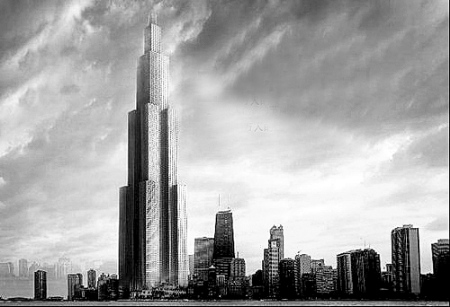
(Ecns.cn) -- In the next three years there will be a high-rise building completed every five days in China, according to statistics cited by China Newsweek.
Skyscraper construction has become obsessively fashionable in China, driven mostly by the ambitions of local government officials.
Apart from hidden dangers caused by human factors such as bad planning and substandard equipment, many high-rise projects have resulted in a waste of resources and unnecessary economic losses, particularly in unfinished buildings.
Construction of high-rises has also accelerated the rise of sea levels, which could aggravate the severity of natural disasters and create water erosion, according to a report released this month by the State Oceanic Administration.
Skyscraper fever
Last month, the local government of Changsha in Hunan Province announced it would build a 220-story skyscraper called "Sky City" in only seven months, China Newsweek reports.
At 838 meters, the building would top Dubai's Burj Khalifa and become the tallest structure in the world. The skyscraper would not be for business, but provide apartments for 174,000 people, with a hotel, school, hospital, offices, shops and restaurants occupying the remaining real estate.
The agreement was signed between Broad Sustainable Building (BSB) and authorities from Changsha's Wangcheng district, where the building is to stand.
Changsha is only a provincial capital, not even a first-tier metropolis – an unlikely location for the tallest building in the world.
Despite a gloomy picture for property markets, skyscrapers around the country appear to be competing for height, according to China Daily.
In April, Chongqing, one of China's four municipalities, launched the Commercial Cluster of Chongqing Tiandi, where the tallest building in the compound reaches 468 meters.
Wuhan, the capital of Hubei province, kicked off construction of the 606-meter Wuhan Greenland Center at the end of 2010, while Ningbo, a port city in Zhejiang province, has opened a 398-meter mixed-use building at the eastern end of the city.
Memorials of waste
In 2011, the total number of skyscrapers under construction in China reached over 200, equivalent to the number in the United States. However, that was only the beginning: the total number is predicted to exceed 800 in five years, according to a report released by SkyscraperCity.com.
For most Chinese who grew up in urban areas, they have seen changing skylines and the transformation of their hometowns into modern cities. Buildings erected decades ago are mostly replaced and those that are not demolished are retrofitted.
In the country's race to urbanize, one can't help but ask: why do governments erect high-rise buildings even if their cities don't need them?
Kuang Xiaoming, professor at the School of Architecture and Urban Planning at Tongji University, said that local governments often have a big say in urban planning, and most officials hope to build skyscrapers as symbols of their achievements.
Some officials not only focus on height, but also have specific requirements for skyscraper developers, said Kuang. For example, before building the 420-meter Jin Mao Tower in Shanghai, an official told the contracted architectural firm that the high-rise must have exactly 88 stories.
High-rise projects are often reflections of officials' vanity, so they always want buildings to be as high as possible, added Kuang.
In the United States, there are currently only 13 skyscrapers at a height of over 300 meters, but in China the number has far exceeded that, said China Newsweek.
Problems
Economic analysts point out that local governments usually plan to build skyscrapers during periods of easy credit and robust investment, but once the economy is depressed, some projects either go unfinished or are unable to attract commercial tenants after completion.
When the height of a skyscraper exceeds 300 meters, its rate of utilization is largely reduced, said an industry watcher, adding that most super high-rise buildings have problems with low occupancy rates because they have much higher maintenance costs.
Safety is another concern for the construction of high-rises. In 2010, a devastating fire killed more than 50 people in a 28-story apartment tower in Shanghai. Since then, safety issues caused by living in skyscrapers have been widely watched.
Most of the worry is over how to deal with fires and elevator malfunctions. Experts advise that governments should avoid the blind pursuit of high skyscrapers and strengthen the supervision and management of such projects.

Copyright ©1999-2011 Chinanews.com. All rights reserved.
Reproduction in whole or in part without permission is prohibited.